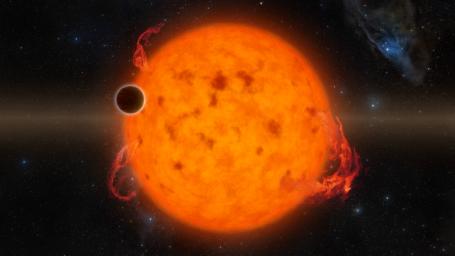
|
Exoplanet Orbits Youthful Star (Artist’s Concept)
- Click the image above for a larger view
- Full-Res JPEG (4800 x 2700) (997.4 kB)
- Full-Res TIFF (4800 x 2700) (27.3 MB)
Caption:
K2-33b, shown in this illustration, is one of the youngest exoplanets detected to date. It makes a complete orbit around its star in about five days.
These two characteristics combined provide exciting new directions for planet-formation theories. K2-33b could have formed on a farther out orbit and quickly migrated inward. Alternatively, it could have formed in situ, or in place.
Background Info:
NASA's Ames Research Center in California's Silicon Valley manages the Kepler and K2 missions for NASA's Science Mission Directorate. NASA's Jet Propulsion Laboratory in Pasadena, California, managed Kepler mission development. Ball Aerospace & Technologies Corporation operates the flight system with support from the Laboratory for Atmospheric and Space Physics at the University of Colorado in Boulder.
More information about the Kepler mission is at http://www.nasa.gov/kepler .
Cataloging Keywords:
| Name | Value | Additional Values |
|---|---|---|
| Target | K2-33 | |
| System | K2-33 | |
| Target Type | Exoplanet | |
| Mission | Kepler | |
| Instrument Host | Kepler | |
| Host Type | Space Telescope | |
| Instrument | ||
| Detector | ||
| Extra Keywords | Artwork, Atmosphere, Color, Infrared, Orbit | |
| Acquisition Date | ||
| Release Date | 2016-06-20 | |
| Date in Caption | ||
| Image Credit | NASA/JPL-Caltech | |
| Source | photojournal.jpl.nasa.gov/catalog/PIA20690 | |
| Identifier | PIA20690 | |
